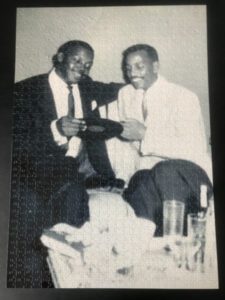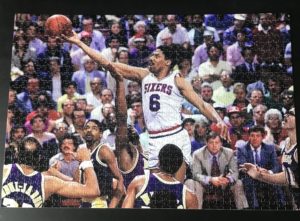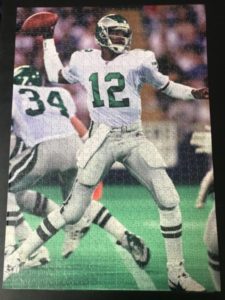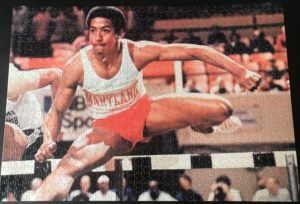Just Chillin
August 16, 2020
So what have I been up to the past few months since the coronavirus smacked us all in the face? In the words of Brotherman from the Martin TV show, “just chillin.” The small private school where I teach high school English went virtual last March, and stayed virtual through the end of the year. So I was home pretty much all day after that, and stayed home all day throughout the summer.
When I wasn’t playing Solitaire on my phone, I was either napping, working on a 1,000-piece jigsaw puzzle, or working on the biography I’m writing on Renaldo Nehemiah. (If I have to explain to you who he is, then you don’t belong on this site).
I found a website that lets you upload a photo that they convert into a puzzle, then they ship you the puzzle so you can put it together. Over the summer I finished ten 1,000-piece puzzles. The first one was of a photo of my dad and a friend of his from when they were in their twenties. In the photo, taken in 1953, Dad’s friend is holding a 78 rpm record as they both are looking at it and smiling. Dad was who I got my love of jazz from, so that one means a lot to me. The second puzzle was of a photo of my mom taken just a few years before she passed in June 2019. In the photo, she is wearing her winter coat and stylish hat, looking upwards and smiling. That puzzle and the puzzle of my dad are side by side on my bedroom wall. It’s a way of keeping them with me. I also did puzzles of a few of my favorite sports heroes, like Dr. J, Randall Cunningham, and Nehemiah. And of course, I had to do one of the one and only John Coltrane.
Solving jigsaw puzzles and writing a biography are similar endeavors. Both involve taking that which is fragmented and making it whole. Both involve putting together individual pieces and finding where they best fit in the larger picture. While doing a puzzle and writing a book, you have to focus on the minute details, because if you try to focus too soon on the bigger picture, you’ll lose sight of what needs to be done right here and now. The reason a biography is even harder is because you have to create the pieces yourself first. You have to conduct multiple interviews, find the articles, books, videos, websites, etc. that will add layers to the story. Then you have to figure out where to add them, and how to put them together in a manner that reads like you’re just having a casual conversation with the reader. Writing is hard work. It’s a grind. It’s not about inspiration and dreams. It’s about word choice and sentence structure and phrasing. It’s about having a plan and sticking to the plan, or deviating from it when deviation becomes necessary. Writing a biography is a unique challenge because it requires an exceptionally high level of empathy. When I’m writing about Renaldo Nehemiah, I can’t allow myself to feel like I’m writing about someone outside of my own identity. In my mind, I have to become Renaldo Nehemiah. I have to feel how he felt when he ran at the 1980 Olympic Trials knowing he wouldn’t have an opportunity to compete in the Games. I have to feel how he felt when he tore his hamstring as a high school sophomore and feared that he wouldn’t run competitively ever again. I have to feel how he felt when he crossed the finish line in Zurich in 1981 and saw the winning time of 12.93 on the scoreboard. The highs and the lows—I have to write about them as if I’m experiencing them. Or else my voice won’t be authentic.
The Nehemiah biography keeps growing as I write. I’m still working on the first draft. In a big writing project like this, the first goal is to get the first draft done. You can always go back and change things, move things around, take things out, add things in. But if you don’t get that first draft done first, you can sink into despair and give up on the project altogether. That’s why I always tell myself, keep grinding. During the summer months, I’ve challenged myself to write 2,000 words per day. I’ve reached the goal most days, but other days I haven’t, especially when I’ve had to do more research or re-read previous interviews I’ve conducted so that I’m in the proper mental space.
Nehemiah was as gifted and as special an athlete as any 20th century athlete you could name. In my initial outline, I was planning to cover his four years at the University of Maryland (1978-1981) in one chapter. Then I realized that I would probably need to divide it into two chapters—1978-79 and 1980-81. But when I got to writing that part of the book, it became clear to me that each of those years needed its own individual chapter. The dude broke so many records so many times, indoor and outdoor, that just about every race he ran needed to be discussed in detail. That’s only a very slight exaggeration.
Right now I’m working on Chapter Seven, which covers the 1982 indoor season, and then his decision to leave behind amateur track in favor of playing professional football for the San Francisco 49ers. My hope is to complete the first draft by the end of 2020, and hopefully have the book published by the end of 2021.
Meanwhile, I go back to school tomorrow, in the building, with mandatory masks, mandatory social distancing (desks in each classroom are spaced six feet apart), and plenty of other protocols in place. I don’t want to go back to school. I’ll miss my puzzle time and I’ll have to fight to make time to work on the book. I’ve been walking four miles a day every morning at a local park; I won’t have time for that anymore. But I did buy a treadmill, so I’ll still get my workout in. But I’ll no longer have the company of the trees and the birds and the bunny rabbits (and the sweet old couple who, when I told them I wouldn’t be coming to the park anymore because I was going back to the classroom, asked me my name so they could pray for me). But I’m glad to be going back to school because there are people there who need me, and I want to be there for them.
As far as coaching goes, I haven’t done much of it, and I don’t really miss it. I was burnt out from coaching when corona came, and was glad for the break it afforded me. There’s a lot of drama in track and field, and I often feel like my artistic approach doesn’t align with the I-need-to-get-faster-now mentality of so many athletes, parents, and coaches. But it’s all good. I’ll never leave behind the hurdles.

That’s my dad on the right, and his friend on the left.

My dear, beloved mother.

The good doctor Julius Erving with the finger roll against the lakers.

Randall Cunningham, who was 90% of the Eagles’ offense back in the day.

Trane….

The most graceful, fluid, awe-inspiring hurdler to ever run the race.
